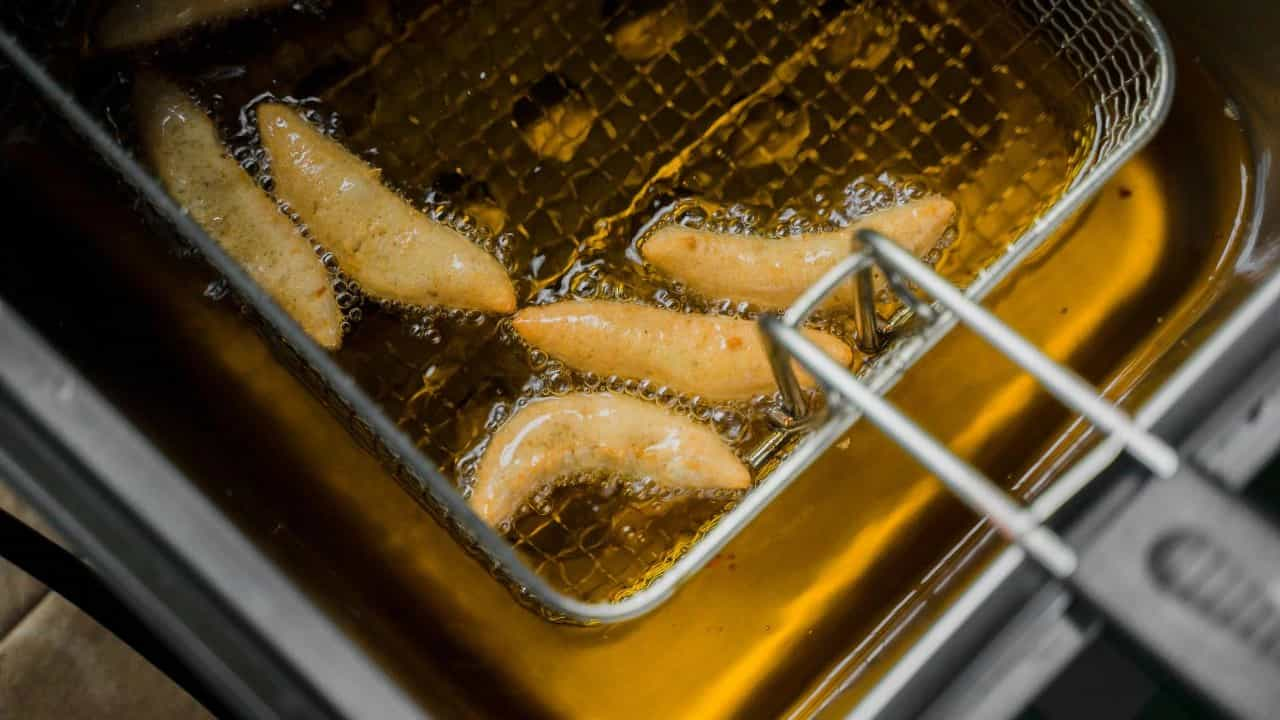In the busy restaurant, “How Often Should Restaurants Change Their Deep Fryer Oil?” is a question every kitchen operator must consider. Did you know high-end restaurants may only change their oil once a week due to lower usage, while fast-food kitchens often replace it daily to maintain freshness? This difference highlights the importance of oil management for food quality and safety. Health departments sometimes require daily oil changes, and failing to follow best practices can result in poor food quality, health code violations, and financial losses. Let’s explore how proper fryer oil management can significantly impact your kitchen’s success.
Factors Affecting Fryer Oil Lifespan
In today’s fast-paced restaurant world, knowing what affects your fryer oil’s life is key. It helps make sure your food is top-notch and your costs are down. Looking into how to care for fryer oil shows clear ways to make it last longer in different cooking situations. This also depends on the type of oil. If you are unsure which oil to choose for frying in a restaurant, we have prepared recommendations for choosing the best oil for frying.
Type of Food Being Fried
What you’re frying changes how fast the oil breaks down. For example, foods with breading or batter release more bits into the oil, making it dirty faster. Particularly, frying breaded fish means you need to change the oil after only 2 to 3 uses because of fast contamination.
Frying Temperature
Frying at higher temperatures makes the oil go bad quicker. It creates bad substances like aldehydes, which could cause serious health issues, including cancer. So, keeping an eye on the fryer’s temperature is critical for health and keeping the food’s quality high.
Volume of Food Fried
More food in the fryer, especially during busy times, really pushes the oil. In busy kitchens, this means the oil might need to be changed daily or weekly, depending on what’s being cooked and how much of it there is.
Filtration Practices
Cleaning the oil well can make it last longer. It takes out bits of food and other bad stuff. Restaurants should clean their oil at least two times a day for the best oil quality. Also, using Total Oil Management systems can help keep the oil good for longer, making the food better and customers happier.
| Type of Food | Recommended Change Frequency | Impact of Filtration |
| Breaded or battered | 2-4 uses | Crucial for extending oil life |
| Non-breaded items (e.g., french fries) | 6-8 uses | Benefits from regular filtration |
| Breaded fish | 2-3 uses | Necessary to prevent rapid rancidity |
| All foods | Daily or weekly based on volume | Consistent filtration ensures quality and health safety |
To sum up, sticking to solid fryer oil care tips is crucial. It keeps your food great and your kitchen running smoothly. Watching the fryer temperature, cleaning the oil well, and changing it when needed are key actions for top-notch service in the food world.
Signs It’s Time to Change Fryer Oil
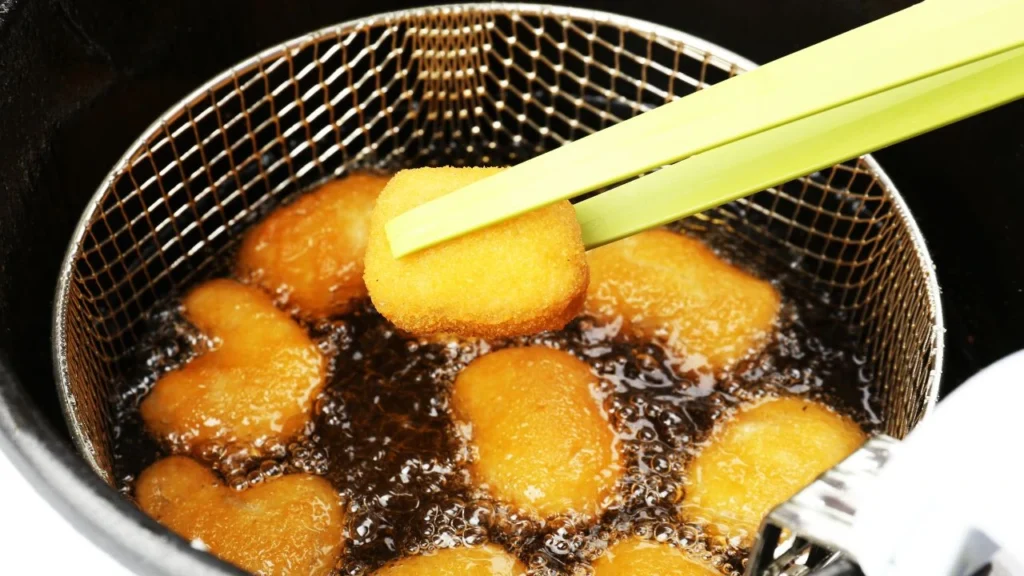
Knowing when to switch fryer oil is key for any eatery wanting to keep food delicious and kitchens safe. Spotting when to change the oil impacts taste, quality, and kitchen health. Here are the main signs you need a new batch.
Visual indicators
Oil that turns darker or thick is a bad sign. This change means the oil is starting to spoil. It’s less effective and could ruin your food.
Sensory indicators
Changes in how the oil smells or tastes are big red flags. If your food starts tasting odd or the oil smells bad, it’s time for new oil. These issues can ruin the meals you serve.
Performance indicators
When oil smokes at low heat or food cooks slowly, your oil may be bad. Food not getting crispy also means the oil isn’t working right.
Safety concerns
In a busy kitchen, safety is super important. Foam on your oil or smoke at low heat can be dangerous. These signs mean you need to change the oil and check kitchen safety.
Keeping your fryer oil in good shape improves taste and safety. It’s important to watch for these signs. Tools like oil test strips or oil testing kits help check your oil’s condition.
Changing your oil regularly, based on these signs, keeps it working longer. This ensures your meals are always tasty, safe, and of the best quality for your customers.
Recommended Frequency for Changing Fryer Oil
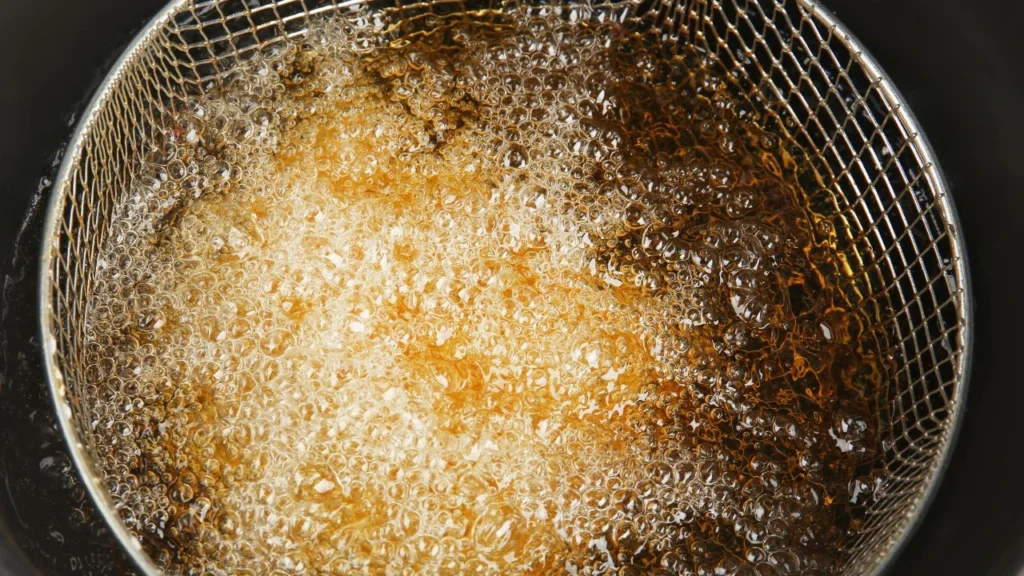
It’s important to know when to change fryer oil in commercial kitchens. The right time can depend a lot on how much food you fry. These changes keep food tasting good and kitchens safe.
High-volume scenarios
In busy places like fast food restaurants, changing oil every 3-5 days is needed. This keeps up with the busy fryer use. It also stops oil from getting bad, which keeps food tasty and safe.
Checking the oil every day and filtering it are good steps too. They help make sure the oil stays in good shape.
Medium-volume scenarios
Casual dining spots usually change their fryer oil every 5-7 days. This schedule works well for their needs. It helps serve quality food without changing oil too much.
Low-volume scenarios
Fine dining restaurants often change oil every 1-2 weeks. They fry less food. Keeping oil fresh longer is key for the top-notch dishes they serve.
Special considerations
There are other things that can change how often you need to switch oil. For instance, using different fryers for fish and fries keeps flavors right. Having a good oil filtering plan helps oil last longer and keeps food quality high.
Adjusting how often you change fryer oil for your kitchen’s needs helps a lot. It keeps food quality up and costs down. Getting this balance right is great for making customers happy in any restaurant.
Best Practices for Extending Fryer Oil Life
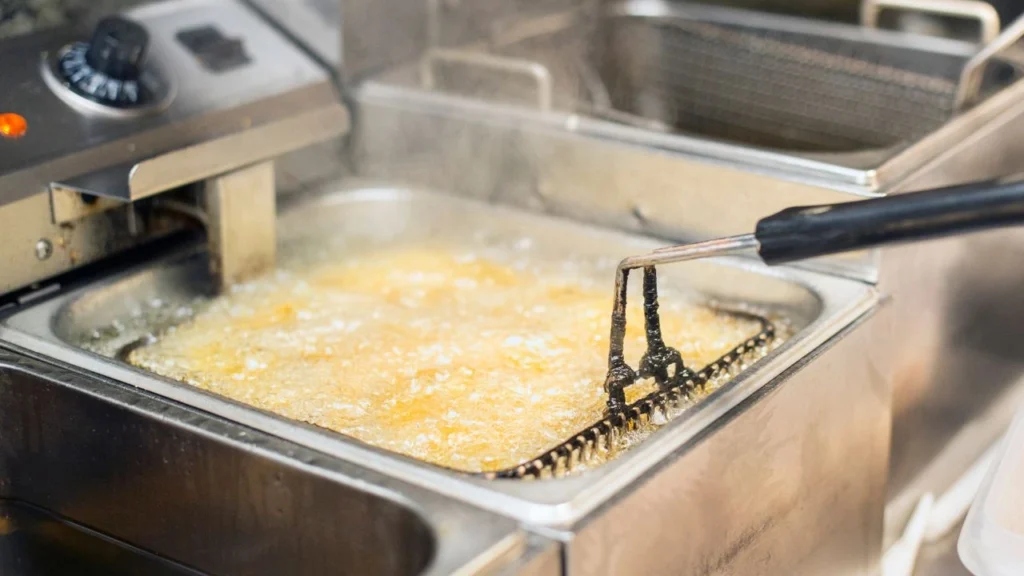
In a busy restaurant, saving resources is key. Extending fryer oil life saves money and keeps food tasty. This shows a commitment to efficiency and pleasing customers. It’s important to know the best times for changing fryer oil. Using the right strategies to make fryer oil last longer is a big part of kitchen management.
Maintenance procedures
Good maintenance is vital for fryer oil’s longer life. Filtering the oil at least twice a day greatly helps its life and quality. Training your team to clean the fryer every 15 minutes removes bad particles. Turning off fryers when not in use stops the oil from breaking down too fast.
Monitoring systems
Using advanced monitoring systems, like Total Oil Management, changes the game. They help track oil filtering and manage oil use. This includes automatic alerts and detailed reports. Regularly using oil test kits also helps. It lets you know the right time to change the oil based on its quality.
Staff training
Consistent fryer oil management depends on well-trained staff. Offering regular training sessions gives the team the skills they need. They learn the best ways to change and maintain oil. Stressing the importance of correct oil levels and how to filter and dispose of oil properly ensures effective management.
Equipment care
Looking after the fryers is as important as the oil they use. Checking and adjusting fryer settings every quarter makes sure they work right. This avoids overheating or not using them enough, which can ruin oil fast. Covering fryers when not in use keeps out dirt and helps the oil last longer while keeping food safe.
By adopting these key practices, restaurant owners and chefs can make their fryer oil last longer. This leads to saving money and better service. Following these steps improves how a kitchen runs. It also helps the environment by cutting down on oil waste.
Guidelines for Food Service
In the food service field, knowing how to maintain fryer oil is key for any restaurant. This is important for extending the life of fryer oil. By following specific oil management steps, sticking to rules, and optimizing costs, restaurants can work better and save money. These methods also keep up with health and safety rules.
Oil Management Practices
Keeping oil quality high is very important. Using quick tests to check oil’s condition makes sure it’s changed at the right time. Specifically, before it hits 24% Total Polar Materials. Tools like commercial kits help in accurately assessing the oil’s state.
Regulatory Compliance
Regulation focuses on the need for using the right kitchen materials. Like choosing stainless steel for fryers over other materials. Teaching staff about these rules and proper oil care is key for safety and following laws.
Cost Optimization
To save money without losing quality, using modern oil systems is essential. For instance, Darling Ingredients Canada has containers and systems like Cleanstar and Exterior B.O.S.S. These are designed for different restaurant needs.
| Tank Model | Capacity (kg / L) | Dimensions | Special Features |
| Cleanstar® GRN | 612 / 681 | N/A | Small-scale operations |
| Exterior B.O.S.S. | 1020 / 1135 | N/A | High volume handling |
| Fat4Fuel Tank | 573 / 638 | 83″ h / 24″ w / 24″ d | Compact design |
| Cleanstar 2500 | 1122 / 1249 | N/A | Outdoor use, high capacity |
By adding top-notch devices and following the right oil care tips, restaurants can make their fryer oil last longer. This boosts savings and meets environmental goals.
The Impact of Oil Quality
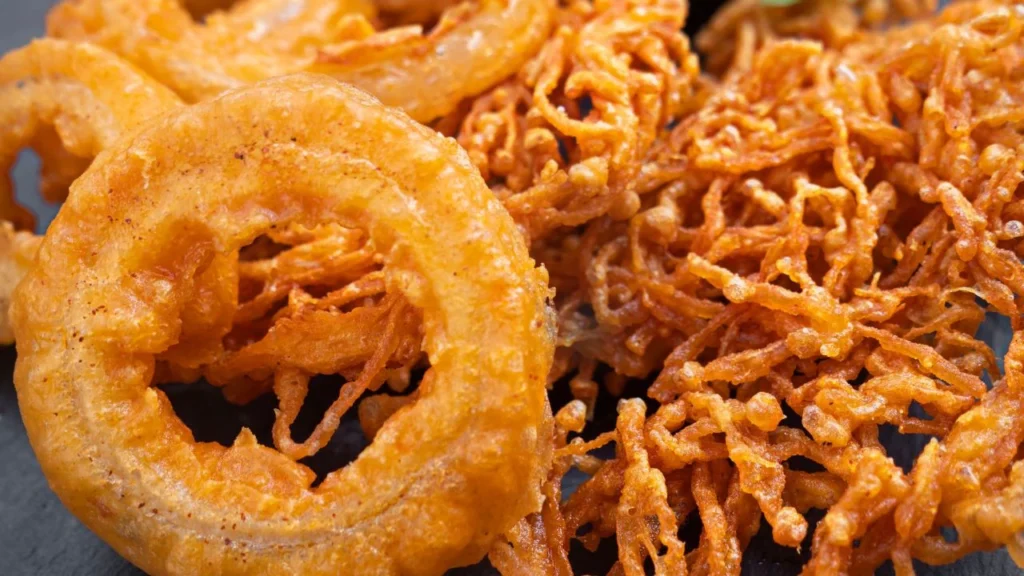
It’s crucial to understand how vital fresh fryer oil is in the culinary world. Quality oil improves not just the taste and look of food, but also efficiency and eco-friendliness.
Food Quality Effects
Bad oil can make food taste burnt, smokey, musty, or bitter. This makes meals less appealing. Good frying oil means tastier food, which keeps customers coming back. Products like FreshFry Pods help keep oil clean, preserving flavors for longer.
Business Implications
A restaurant can suffer if its oil quality drops. Keeping oil fresh is more affordable in the long run. It cuts down on oil changes and machine problems. Plus, using the right oils reduces the risk of burnt flavors.
Cost Considerations
Knowing when to switch fryer oil is about balancing costs and quality. The Testo 270 cooking oil tester can measure oil life accurately. This helps avoid changing oil too early and saves money.
Environmental Impact
Fresh oil matters for more than just good taste and saving money. Recycling used oil helps the planet. Programs like Mopac not only recycle but also pay you, showing green practices can be profitable.
By focusing on enhancing fryer oil quality, businesses can achieve top food quality, efficiency, cost savings, and eco-friendliness. This complete approach leads to culinary success.
The Importance of Fresh Fry-Oil
The importance of fresh fryer oil in professional kitchens is huge. It affects the food’s taste, quality, and even the restaurant’s costs and environment. Experts suggest changing the oil after 6 to 8 uses, especially for non-breaded items. For breaded foods, change it more often. This knowledge helps maintain top-notch frying operations.
Develop Management Plan
Make a detailed plan based on expert advice. Include regular filtration and correct oil storage. This plan supports your commitment to prolonging fryer oil quality. Train your team to spot bad oil and realize fresh oil’s importance for health.
Implement Best Practices
Put your plan into action. Choose the right oil and teach your team proper maintenance. This effort saves money and showcases your care for customer health and the environment. It strengthens your restaurant’s reputation as a place that values responsibility and health.
Consider Environmental Impact
Think about the environmental effect of your frying practices. By using and disposing of fryer oil wisely, you reduce waste. This step aligns your business with the growing demand for sustainability. It’s about being responsible for our global footprint, not just following a trend.
FAQ
How often should restaurants change their deep fryer oil?
Restaurants usually change their deep fryer oil weekly. However, this varies based on food volume and type. High-volume places change oil every 3-5 days. Meanwhile, low-volume spots might go 1-2 weeks.
What factors affect fryer oil lifespan?
The lifespan of fryer oil depends on several factors. The type of food, frying temperature, and food volume matter. So does how well the oil is filtered.
What are the signs it’s time to change fryer oil?
It’s time to change fryer oil when it darkens or smokes at lower temperatures. Bad smells or changes in food taste are signs, too. Performance issues indicate it’s time for a change.
What is the recommended frequency for changing fryer oil in high-volume versus low-volume scenarios?
Fast food places should change oil every 3-5 days. Medium-volume places might wait 5-7 days. Fine dining places, with less volume, can go 1-2 weeks with good care and filtration.
What are the best practices for extending the life of fryer oil?
To extend fryer oil life, keep fryers clean and dispose of oil properly. Use oil test kits and train staff in oil management. Keeping equipment in shape is also important.
What oil management practices are crucial in Canadian foodservice for compliance and cost optimization?
In Canada, managing oil well is key to meeting rules and cutting costs. It’s important to use fryer oil fully without losing food quality. Modern oil-saving tech and strict filtration help.
How does the quality of fryer oil impact the restaurant business?
Good fryer oil quality ensures tasty food, which makes customers happy and boosts profits. Bad oil can ruin a restaurant’s reputation. Plus, oil recycling affects the environment.
Resources
https://commercialequipmentserviceinc.com/2022/07/how-often-should-commercial-fryer-oil-be-changed/
https://www.industrykitchens.com.au/Blog/how-often-should-you-change-fryer-oil-restaurant
https://www.industrykitchens.com.au/Blog/how-often-should-you-change-fryer-oil-restaurant
https://www.southernfrykings.com/blogs/blog/how-often-should-you-change-the-oil-in-a-deep-fryer


